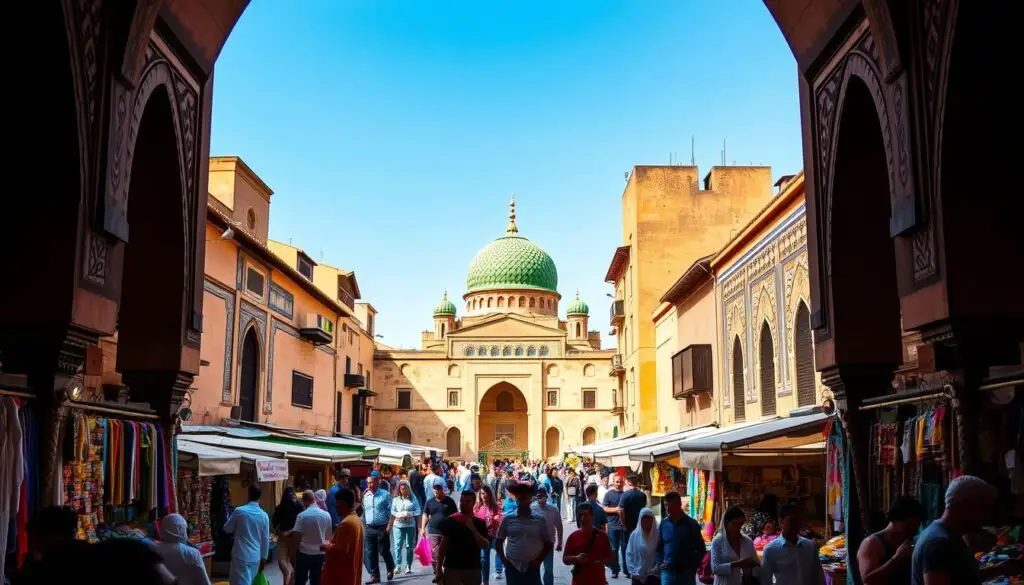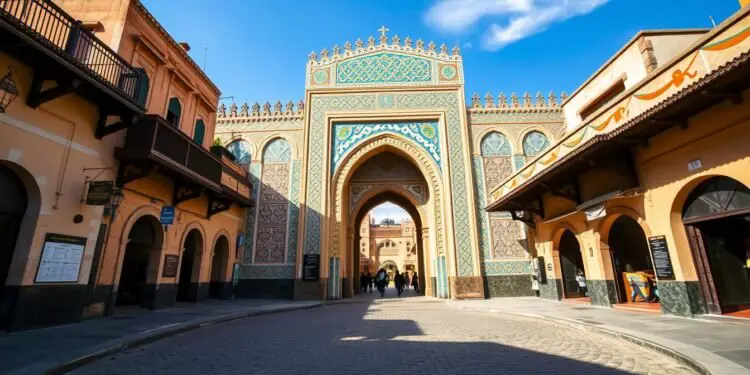Have you ever walked through a door that transports you to another world? The iconic blue-tiled entrance of Bab Bou Jeloud does just that. Standing proudly since 1913, this breathtaking gate marks the western entry to Fes el Bali, Morocco’s ancient medina and a UNESCO World Heritage Site.
Built under French colonial rule, the current structure replaced an older 12th-century gate. Its triple horseshoe arches dazzle visitors with vibrant zellige tiles—blue on the outside, green on the inside—symbolizing the city’s rich heritage. More than just an entrance, it’s the heart of Fez’s labyrinthine streets, guiding travelers into a living medieval world.
Strategically positioned near Bou Jeloud Square, the gate connects modern Fez to its historic soul. Whether you’re capturing its beauty or using it as a landmark, this architectural masterpiece leaves an unforgettable impression.
Key Takeaways
- The current gate was constructed in 1913, blending Moroccan and colonial influences.
- Its blue and green tilework symbolizes Fez’s cultural and religious identity.
- Serves as the main western entrance to Fes el Bali’s UNESCO-listed medina.
- Features three striking horseshoe arches adorned with traditional zellige patterns.
- A key orientation point for visitors exploring the ancient city’s maze-like alleys.
The History and Significance of Bab Bou Jeloud Fes
Few structures capture the blend of history and control like Bab Bou Jeloud. Originally part of the city’s defensive walls, it was rebuilt in the early 20th century under French rule. Today, it’s both a tourist magnet and a testament to colonial urban planning.
From Military Gate to Iconic Landmark
Captain Mellier, chief of municipal services, designed the current structure in 1913. His goal? To replace the older gate with a grand entrance that controlled medina access. The outward-facing locks reveal its true purpose: monitoring movement into the ancient city.
Despite its colonial origins, the gate became a beloved symbol. Its Moorish arches and zellige tiles disguise its functional role. Locals and visitors now admire it as art, not just architecture.
The French Colonial Influence
The French Protectorate used urban projects like this to assert control. By blending Moroccan styles with colonial needs, they created gates that were beautiful yet functional. The gate’s location near key roads made it a strategic checkpoint.
Modern Fez embraces this paradox. A structure built for surveillance now welcomes millions. Its survival shows how history can rewrite a monument’s purpose.
Architectural Marvel: Design and Features
Standing as a masterpiece of Moroccan craftsmanship, this architectural wonder blends history with artistry. Its Moorish revival style features a crenelated top and three horseshoe arches, with the central one soaring 4.5 meters high. Each arch frames minarets in the distance, creating a picture-perfect view.
![]()
The facade dazzles with over 12,000 hand-cut zellige tiles per side. Blue tiles dominate the exterior, symbolizing Fez, while green—Islam’s sacred color—lines the interior. Geometric star patterns and interlaced designs showcase the precision of Fassi artisans.
Unlike Bab Mansour in Meknes, this gate merges traditional motifs with modern materials. Steel reinforcements support the arches, a subtle innovation beneath the historic veneer. The crenellated walls nod to its defensive origins, now softened by artistry.
Every angle reveals new details. From the street, the central arch perfectly aligns with the medina’s skyline. Up close, the tiles’ depth and color shifts captivate. It’s a testament to architecture that transcends time.
Exploring Near Bab Bou Jeloud
Step beyond the historic gate and discover a world of hidden gems. The surrounding area blends medieval charm with lively modern culture. From sacred schools to bustling squares, each site tells a story.

Bou Inania Madrasa: A Masterpiece of Marinid Craftsmanship
Just a short walk away, the 14th-century Bou Inania Madrasa astounds visitors. Its cedarwood carvings and zellige mosaics reflect Islamic artistry. The minaret offers panoramic views of the medina.
Al Batha Museum: A Glimpse into Moroccan Arts
Housed in a former royal palace, this museum showcases traditional crafts. Intricate ceramics, textiles, and woodwork highlight Fez’s artistic legacy. The Andalusian-style garden is a serene retreat.
Bou Jeloud Square: The Pulse of Local Life
By sunset, the square transforms into a cultural stage. Food stalls sizzle with local flavors, while henna artists weave intricate designs. Weekly Gnawa music performances electrify the air.
Petit taxis and calèche carriages buzz nearby, making it a key transport hub. For deeper immersion, visit at night when storytellers captivate crowds under lantern light. Nearby, Jnan Sbil Gardens’ palm groves offer shade.
Visiting Bab Bou Jeloud: Tips and Practical Information
Planning your visit to this iconic landmark? Here’s what you need to know. The GPS coordinates (34°3′42″N 4°59′2″W) will guide you to the historic entrance, but note: vehicles can’t pass beyond the gate.
Park your car at Place Bou Jeloud’s guarded lot—it’s the safest option. The medina’s 9,400 alleys are a maze; consider a guided tour to navigate confidently.
Photographers, aim for morning or evening. The entrance tiles glow differently as light shifts. Avoid unofficial “guides” near the gate—they often overcharge.
The area has ATMs and cafes with rooftop views. Cash is king in the old city. For safety, skip dark alleys and stick to bustling routes.
Nearby, Bou Jeloud square buzzes with food stalls and music. Need a break? Rooftop cafes offer panoramas of the medina.
Conclusion
At the crossroads of time, this blue-tiled marvel stands as a living bridge. It connects Fez’s past and present within its UNESCO-listed walls, where the medina’s world thrives behind the gate.
More than an Instagram spot, it’s the heart of daily life—a dynamic gateway to souks and schools. Pair your visit with the Chouara Tannery to dive deeper into the city’s craft traditions.
As the sun sets, the tiles glow like the blue heartbeat of Morocco’s spiritual capital. Step through, and let history move you.
FAQ
What is the significance of Bab Bou Jeloud in Fez?
This historic gate serves as the main entrance to the old medina. Built in the early 20th century, it blends Moorish and French colonial styles, symbolizing the city’s rich heritage.
Why are the tiles on the gate different colors?
The blue tiles on the exterior represent Fez, while the green tiles on the inside symbolize Islam. This dual design creates a striking visual contrast.
What attractions are near the gate?
Key sites include the Bou Inania Madrasa, Al Batha Museum, and the lively Bou Jeloud Square, all within walking distance.
Can vehicles pass through the gate?
No, the entrance is pedestrian-only, preserving the medina’s historic charm. Nearby parking is available for those arriving by car.
When is the best time to visit?
Early morning or late afternoon offers cooler temperatures and fewer crowds, ideal for photography and exploration.




